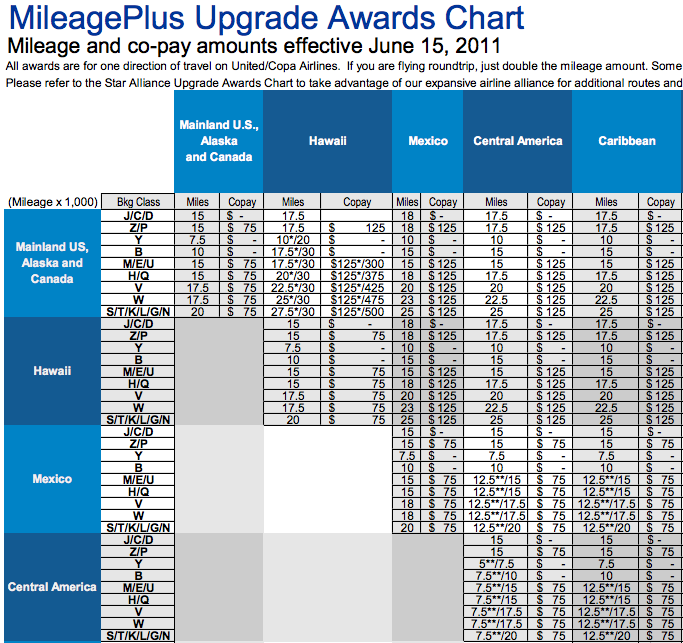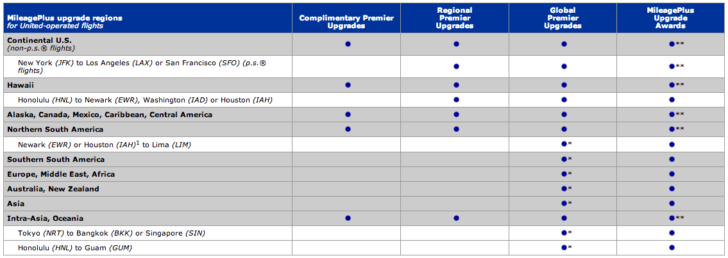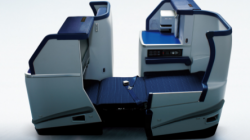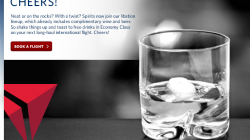Bill wrote in with a question this week on how to upgrade flights with United, and it spurred me to create a short series on all the major domestic carriers. Upgrades on international itineraries are much more complicated than with domestic itineraries. Instead of a status- and fare-based hierarchy for domestic flights processed automatically by computers, there are myriad rules and conditions in place for international fares. In these posts I hope to explain more about the options that are available in each context and which ones are more plausible than others.
I travel on a weekly basis and was wondering if you could help me with a South Africa trip I am taking. I only fly United and was wondering what the policy on international travel is? I typically always get upgraded automatically and was wondering on international flights do I still receive the same complimentary upgrade?
The Basics of Global Premier Upgrades
On the majority of international flights, often the only “free” upgrades are using Global Premier Upgrade (GPU) instruments, which are offered to Premier 1K members. You would need to book a United-operated flight with a United flight number (i.e., no code shares). You would then need to make sure the fare class is at least W or higher (i.e., no deep discount economy class fares). W fares can sometimes carry a premium of about 20% to even 100% over the cheapest available economy fare.
To upgrade from business class to first class, you must have one of these fares:
J, C, D
To upgrade from economy class to business class, you must have one of these fares:
Y, B, M, E, U, H, Q, V, W
For flights that are otherwise eligible for a Regional Premier Upgrade (RPU), there is no fare restriction.
You may also be able to use your GPUs on Lufthansa-operated flights. United suggests that you submit a request at least two weeks before departure so that they can mail you a paper upgrade certificate. You can then submit the certificate to the gate agent. Obviously you’re relying on empty, unsold seats at such a late date. But if the upgrade doesn’t clear, you can return the paper certificate and the GPU will be re-deposited.
GPUs may also be redeposited in some cases when an upgrade doesn’t fully clear. You may upgrade more than one segment as part of a longer itinerary using a single GPU as long as no connection is longer than 24 hours (i.e., a stopover). But if, for example, you are flying from Seattle to Newark to London, and the Newark-London upgrade to BusinessFirst doesn’t clear, you can get your GPU redeposited even if you were successfully upgraded to domestic first on Seattle-Newark.
You may also be interested in other types of upgrades on United Airlines, including domestic upgrades, but keep reading this post for information about upgrades on other Star Alliance partners.
International Upgrade Exceptions
There are, however, a select number of international routes that do qualify for Complimentary Premier Upgrades (CPUs) — though none will help Bill with his trip to South Africa. These include flights to Canada, Mexico, the Caribbean, and Central America. A few flights to the northern reaches of South America and flights within Asia and Oceania are also eligible.
Furthermore, you can jump to the front of the queue by using a Regional Premier Upgrade (RPU), which can be applied to any fare. There are only two cases where a flight can be upgraded with an RPU but are not eligible for a CPU. These are flights from Newark, Houston, or Washington-Dulles to Honolulu; and from San Francisco or Los Angeles to New York-JFK on United’s p.s. flights.
Using Miles to Upgrade Your Flight
Yes, you can use miles to upgrade. There may or may not be a cash co-pay required depending on the fare paid. Even the cheapest economy fares are eligible, but the co-pay can be pretty high for some routes. Because of the co-pay and the high number of miles required, I never recommend using miles to upgrade an award. You are put into a situation where you are facing similar inventory constraints that apply to award seats (in both cases the airline would rather sell it than give it away), so you might as well use a few more miles to book an award in the first place and skip the co-pay. Save the cash to pay for your domestic flights, where upgrades are usually free and you earn more miles to pay for international awards.
The chart for MileagePlus Upgrade Awards (upgrades on United-operated flights) is huge and spans two pages. You can find a PDF of all award and upgrade prices on United’s website, and I’ve included just a small snippet to give you a taste. But since it isn’t shown, the upgrade price for a discount fare from North American to Europe in the S, T, K, L, G, or N fares is 20,000 miles plus $550 each way. In fact, it’s the same price for a W fare. If you have GPUs available, I think you are better off paying $550 more to buy a W fare, apply a GPU, and save 20,000 miles. The caveat is that if the upgrade doesn’t clear, a mileage upgrade will be refunded whereas with a GPU you won’t get the fare difference back. If you have a Y or B fare, there is no co-pay, but you still need to redeem between 15,000 and 20,000 miles each way.
Co-pays are waived for all members with elite status on select routes. These are generally the same routes that are eligible for an RPU (look for the double asterisk), with the exception of flights from Newark, Washington-Dulles, and Houston to Honolulu.
Upgrading on Star Alliance Partners
The really annoying part about using miles to upgrade is that the seats I’d rather have are on United’s partner airlines like Singapore or Swiss. But it’s almost impossible to get those using MileagePlus miles. The award inventory they release is extremely limited, so I can’t just book an award ticket from the start. And the rules for upgrading on all Star Alliance partners are also restrictive. You would need to book a full-price Y or B economy fare or C or D business fare in most circumstances, and the flight must be operated and marketed by the same airline (so an ANA flight would need an ANA flight number, for example).
Note that although most requests can be made as soon as the schedule loads (331 days before departure), Air New Zealand requests must be made within 28 days and Ethiopian Airlines and ANA requests must be made within 56 days. There are also a small number of additional fares are eligible for upgrades beyond the Y, B, C, and D fares mentioned above:
- Air Canada — O
- Air China — W
- Air New Zealand — E, U, and O
- ANA — J, Z, and E
- Ethiopian Airlines — G and S
- Lufthansa — J
- Scandinavian — S
- Singapore Airlines — S, Z, and J
Like with the co-pay issues on United, at this point I think your money would be better spent on domestic flights, where you can upgrade for free, earn lots of miles, and use those miles for international award travel. The most likely people who would upgrade partner flights are business travelers whose employers book them on flexible fares. These are also the same people who are most likely to benefit from the MileagePlus upgrades described above — yet at least those of us with cash to spare can fork over the co-pay if we choose. A Star Alliance upgrade requires booking a pricey fare from the start.
Conclusion
Basically, upgrading most international United flights is expensive. You either have to buy an expensive fare or pay an expensive co-pay, even if you already have top-tier elite status. But there are still cases where it can be less expensive rather than more expensive. A $550 co-pay on a United-operated flight with an L fare is still a better deal than buying a full-price Y fare on Lufthansa. Using a GPU on a W fare is better still assuming you don’t mind the risk that you’ll have paid for a mid-priced fare even if the upgrade doesn’t clear.
But knowing what you can and can’t do is the first step to not making an even more expensive mistake. You don’t want to be the person who books a Y fare, tries to apply a GPU, and gets stuck. Or who books an ANA flight with a United flight number. In these cases, remember that flights that pass through the United States can be cancelled within 24 hours, giving you an opportunity to rebook. Or, if you started with an overly restrictive fare, you may be able to “re-fare” your itinerary by rebooking on the same flight into a higher fare class.






